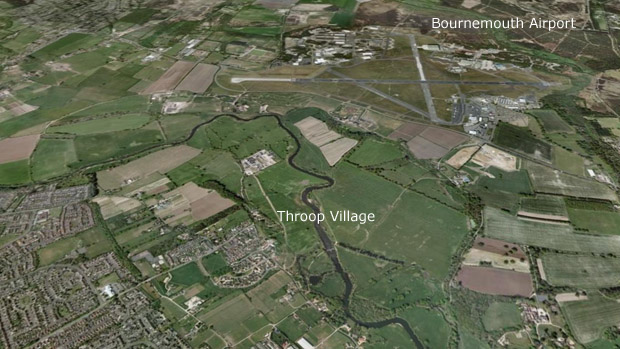Pilot killed in Red Arrows crash near Bournemouth
The Ministry of Defence has confirmed that 33-year-old Flight Lieutenant Jon Egging was killed when his Red Arrow crashed earlier.
The plane plunged to the ground near Bournemouth Airport in Dorset after a demonstration at the town’s Air Festival.
Dorset Police said that Jon Egging was thrown from the aircraft and pronounced dead at the scene.
Chief Inspector Steve White, of Dorset Police, said: “On approach to the airport one aircraft crashed into a field near Throop Mill, Bournemouth.
“The aircraft came to rest on the banks of the River Stour, and the emergency services including police, fire, ambulance, coastguard search and rescue and a Dorset and Somerset Air Ambulance attended.
“Sadly the pilot, who had been thrown from the aircraft, was pronounced dead at the scene.”
He said the emergency services responded as soon as they received information of the crash, and added that he did not know whether the pilot ejected from the aircraft.
Tributes paid to 'exemplary' Red Arrows pilot
The wife of Flt Lt Jon Egging, who died when his plane crashed near the Bournemouth Air Festival, said watching his final display made her feel the proudest she'd ever been.
Group Captain Simon Blake, the Commandant of the RAF’s Central Flying School, described the 33-year-old pilot from Rutland as “a true team player”.
He said: “Flt Lt Jon Egging, known as Eggman, joined the team as Red 4 in the autumn of 2010.
“A gifted aviator, he was chosen to fly in the Red 4 slot, on the right hand outside of the famous diamond nine formation – an accolade in itself being the most demanding position allocated to a first year pilot.
“Throughout his winter training and the display season to date, his professionalism, skill and humility have shone through.
“A true team player, his good nature and constant smile will be sorely missed by all. In such a close knit team, this tragedy will be keenly felt by his fellow team members, the Reds, and all of the engineering and support staff, the Blues.”

Flt Lt Egging was inspired to fly by his airline pilot father, who used to let him into the cockpit for takeoff and landing.
He joined the RAF in 2000 and in April last year he moved on to teach at the Harrier Operational Conversion Unit at RAF Wittering, Cambridgeshire. He enjoyed running and travelling with his wife, Emma.
An MoD spokesman said: “A full service inquiry into the details of the crash has been initiated. It would be inappropriate to speculate on the causes of the incident at this time.”
Eyewitness Shaun Spencer-Perkins said the plane came down in fields, near a river.
“I heard a rushing sound and I saw a plane about 15 metres (50 feet) above the ground, racing across the fields,” he told the BBC. “It impacted and bounced across the field.”
He was out for a walk with his family when he saw the aircraft come down. He said:
“It actually came down about 100 metres from us. We ran to it, we were there shortly. Most of the plane was on the other side of the riverbank although on our side there was loads of pieces of debris, spreading across the fields about 100 metres.
“Two guys jumped into the water in front of us to try and look for the pilot, whilst we ran into the field following the debris path to the point of the impact.
“But there were several places were bits of the plane had come down there was a piece of the tail of the plane about 100 me from the impact site.
“And it looked like fuel had caught fire above the ground – there was a huge black mark and a horrendous smell of aviation fuel.”